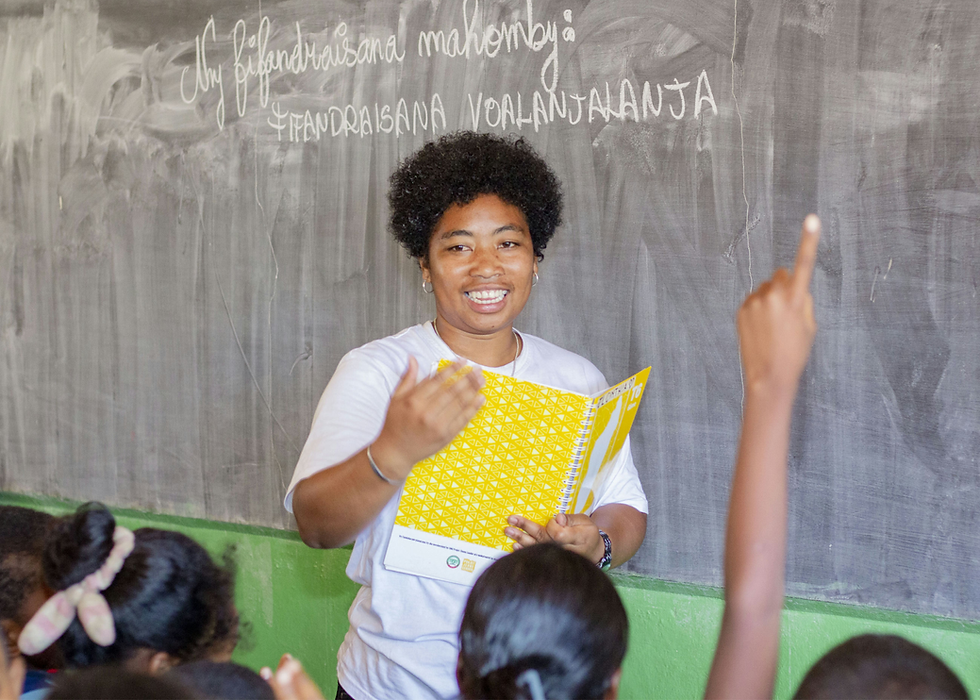PJL Educators as Change Agents: Insights from a most significant change activity
- Laura Leeson

- Feb 24, 2021
- 4 min read
Updated: Oct 23, 2021
In 2018, Projet Jeune Leader expanded to two urban schools in a new region of Madagascar with the support of our long-time partner, AmplifyChange.
These were our first partner schools outside the Haute Matsiatra region, where we have been working since our founding in 2013.
The first cohort of five PJL Educators taught weekly comprehensive sexuality education classes - formally integrated into students' timetables - following our year-long curriculum. When they were not teaching, they were providing other essential services to students: counseling, medical referrals, and fun and educational extracurricular activities.

PJL Educator Santatra teaches a lesson on female reproduction and menstruation.
In February 2020 we conducted a participatory Most Significant Change activity from the Gender and Adolescence: Global Evidence project with these five Educators. Our aim was to better understand the changes that PJL Educators value in the program for the adolescents they serve.
Six themes emerged from the stories of change the Educators shared about their students. Together, they then ranked the themes on how on important they viewed each change. Their final list of ranked changes seen among students looked like this:
1. Increased courage to seek help from the PJL Educator
2. Enhanced motivation to study
3. Improved courage to talk with parents
4. Boosted self-confidence
5. Improved knowledge
6. Boosted responsibility-taking

PJL Educator Sitraka has a counseling session with one of her students.
Justifying its first place ranking, the theme of students' increased courage to seek help from the PJL Educator was present in nearly all the stories shared that day by the Educators.
Each Educator shared at least one story of a middle school student who sought out counseling regarding painful symptoms of a sexually transmitted infection. The students – feeling that they could turn to no one else for help – were embarrassed and ashamed when they approached the PJL Educator.
The Educators’ stories then took similar turns. In all cases, the Educator brought the student to the local government health clinic, where they had to mediate the discussion between the doctor and the adolescent. Santatra, a female Educator, recalled how the female student with severe pelvic pain and discharge she brought to the doctor was adamant that she had never had sexual intercourse, but then, after delicate intercession from Santatra, revealed that she had been raped at age 13.
While the doctor’s job ended after diagnosis and prescription of medicine, the Educators’ work always continued. The students never had money to buy their prescription, so the Educators explained to students how to best approach their parents or guardians with their problem. With tears in her eyes, Educator Sitraka described one student who could not afford the medicine, yet could not convince her neglectful stepmother to help her – tragically, her stepmother decided to take the student out of school because of the inconvenience of her illness. This is a stark reminder of the odds adolescents are facing in their everyday lives.
With a more positive story, Educator Naina recounted how after spending nearly an hour trying to help a male student decide to ask his older brother for help with treatment costs, he happily saw the student two weeks later who said he was feeling much better after his brother bought him the medicine he needed.
While we originally conducted this Most Significant Change activity to explore unexpected outcomes among our students, it ultimately highlighted how PJL Educators work as system change agents in their day-to-day jobs.
In their stories, they exhibited several roles of change agents, including:
CATALYST: The PJL Educators were the reason that students sought help. They become catalysts because they have come to feel deeply about their students' well-being - and students recognize this. Because they are young adults themselves, PJL Educators humanize their young adolescent students in ways that other adults do not, and acknowledge young people's lived realities.
RESOURCE LINKER: A very special and underrated role the PJL Educators played is that of the "linker," helping students become aware of and make the best use of the health resources that are available.
PROCESS HELPER: The PJL Educators did not just bring their students to the clinic, they helped them navigate healthcare. The doctor was not able to provide the care the adolescents needed until the PJL Educators intervened, facilitated, and helped the adolescent and doctor communicate with one another. Although we do train these healthcare providers to provide more youth-friendly services, the challenges of behavior change mean that adolescent students still have difficulties accessing truly responsive care.
SOLUTION GIVER: The doctor always wrote the student their prescription and moved on to their next patient, unconcerned with whether that student had the means to fulfill that prescription. The PJL Educator took over, placing emphasis on the process (the student getting the help they needed) and not just the content of change (filling the prescription). Being an effective solution giver involves more than simply having a solution. You need to know how it relates to people's needs and concerns. The PJL Educator worked with and counseled the students to approach and talk to the adults in their lives to facilitate positive change beyond a one-time purchase of medicine.
Our Educators are undeniably the most important and innovative part of our program. This activity showed that the most significant changes we have seen among students are likely because of PJL Educators' ability to create conducive structures and improved pathways to support positive outcomes for their individual students - an important, if not essential, part of meaningful and sustainable change.




